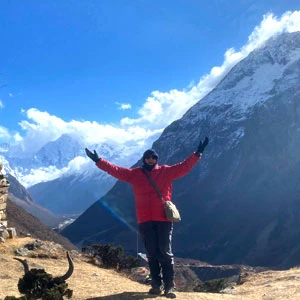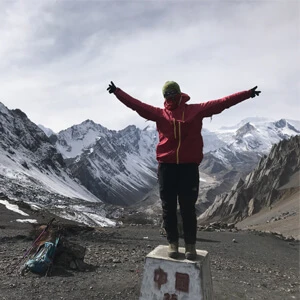Short Manaslu Tsum Valley Trek Difficulty
Despite its shorter version, this trek is a moderately to highly challenging one that requires both physical endurance and mental determination. Here's a breakdown of the key difficulty factors:
Altitude & AMS
The trek starts from the lower hills of Machha Khola (870 meters) and climbs steadily to Larkya La Pass (5,160 meters). Over the days, this dramatic gain in elevation exposes you to the risk of Acute Mountain Sickness (AMS).
Generally, as you move from Samagaun (3,530 meters) upward, thinner air and lower oxygen levels highly trigger symptoms like headaches, nausea, and breathlessness if you are not properly acclimatized.
Trail Conditions & Terrain
The trail of Manaslu Tsum Valley offers a constantly changing terrain. Early on, you will walk through dense forests, bamboo groves, and terraced fields, often on narrow paths. As you enter Tsum Valley, you should expect steep ascents, exposed ridges, and trails surrounded by rhododendron and pine forests.
Following it, the route gets increasingly rugged and alpine once you rejoin the Manaslu Circuit, up until Namrung. The trails are generally rocky with glacial moraines and snow-covered passes, especially around Larkya La.
Daily Walking Hours & Physical Strain
Each trekking day on this trail ranges from 6 to 8 hours, though some days, like the Larkya La crossing, can stretch to 10 hours or more. During this trek, you will have to face prolonged climbs, continuous altitude gain, and several descents over loose rocks.
These harsh walking hours may lead to muscle fatigue and exhaustion. Hence, you will need a decent level of fitness, strong legs, and the ability to walk on varied terrain for days at a time without rest.
Remoteness & Isolation
Unlike more commercial trails in Nepal, the Manaslu region is wild and remote. While you will get wifi and charging services in most parts except in Mu Gompa and Dharamsala, they may not be reliable.
Likewise, tea houses are more basic and sparse compared to the Annapurna or Everest regions. Also, this isolation means you are far from immediate help if anything goes wrong.
Weather & Temperature
The weather in the Himalayas is notoriously unpredictable. Even in the peak seasons (Spring and Autumn), conditions can shift rapidly. You might witness that even warm sunny mornings can turn to cold winds, rain, or snow by afternoon. Similarly, at higher altitudes, temperatures can drop below freezing, especially at night.
Best Time for the Short Trek to Manaslu Tsum Valley
This short trek to Manaslu Tsum Valley is a breathtaking journey through remote Himalayan landscapes, but timing is everything. For this trek, Spring and Autumn are the best times of the year.
Spring (March to May)
Spring is one of the most rewarding times as the weather begins to warm up after Winter. The daytime temperatures range from 10°C to 20°C in lower regions. Snow begins to melt and hence, high passes like Larkya La become more accessible by late March.
If you are trekking in this season, you will find crystal clear skies, offering unobstructed views of Mt. Manaslu, Ganesh Himal, Himalchuli, and surrounding peaks. The views from Mu Gompa and Pungen Gompa are especially dramatic under the Spring sun.
Likewise, the lower trails, especially from Machha Khola to Chumling are lush and forested, with blooming rhododendrons, wild orchids, and magnolias. Moving on, the forested hills from Bhimthang to Goa after crossing Larkya La Pass are filled with pine trees as well as rhododendron plants.
Altogether, Spring is also a great time for spotting Himalayan birds, langurs, and even musk deer if you are lucky.
Autumn (September to November)
Autumn is another ideal season for this trek and arguably the most popular. After the Monsoon rains cleanse the landscape, the air turns crisp and visibility improves dramatically. You will find pleasant daytime temperatures (10°C to 18°C in lower areas).
Moving on, the trails are dry and stable, making trekking conditions optimal. You will pass through harvest-ready fields, and the villages are in the festive mood with the upcoming Dashain and Tihar festival.
If you are trekking in this season, you should expect excellent chances to see blue sheep, Himalayan tahr, and a variety of birds.
Off-Season: Winter (December to February) & Monsoon (June to August)
Winter in the Manaslu region is brutal at high elevations. Snowfall often blocks Larkya La Pass, and temperatures can drop to -20°C at night. While the lower villages like Jagat or Chumling might still be accessible, much of the upper trail becomes difficult and isolated.
On a similar note, Monsoon brings heavy rainfall, landslides, leeches, and poor trail conditions. The Budhi Gandaki region is especially prone to mudslides and flooding, and the cloud cover obscures mountain views. On top of it, the trails can get quite slippery and hazardous due to constant rainfall during this season.
Required Permits For Short Manaslu Tsum Valley Trek
Manaslu Restricted Area Permit (Special Permit)
- Issued by: Department of Immigration (via trekking agency)
- Cost: Sept to Nov: USD 100 (first 7 days), then USD 15 for each additional day & Dec to Aug: USD 75 (first 7 days), then USD 10 for each additional day
- Minimum of 2 trekkers and a licensed guide required
Manaslu Conservation Area Permit (MCAP)
- Issued by: Nepal Tourism Board
- Cost: NPR 3,000 per person
Annapurna Conservation Area Permit (ACAP)
- Issued by: Nepal Tourism Board
- Cost: NPR 3,000 per person
- Required as the trek exits through the Annapurna region
Tips For A Successful Short Trek To Manaslu Tsum Valley
- Secure the Manaslu Restricted Area Permit, MCAP, and ACAP through a registered agency before your trek.
- Choose to trek in Spring (March to May) or Autumn (September to November) for clear skies, better trail conditions, and stunning views.
- Train at least 3 to 4 weeks prior to the trek with cardio and strength training to handle long walking hours and altitude gain.
- Stick to the itinerary, stay hydrated, and don’t skip the rest of the days to avoid altitude sickness.
- Pack light and smart. Layer your clothes.
- Carry enough Nepali cash during the trek.
- Drink plenty of water and eat nourishing meals to maintain energy levels.
- Buy travel insurance that covers high-altitude trekking and emergency evacuation.
Transportation Availability on the Short Manaslu Tsum Valley Round Trek
Your journey to the remote Manaslu region begins with a long yet fascinating road adventure from Kathmandu to Machha Khola, the trek’s starting point. You have several ride options that you can choose from depending on your preferred experience and budget.
Here, you can take local buses from Gongabu Bus Park which will be a 9 to 10-hour ride. Though affordable, this local experience is often rough as the buses get crowded, make frequent stops, and rattle along bumpy dirt roads.
Once your trek ends at Tilije, you will take another bus ride to either Kathmandu or Pokhara. Now, if you are seeking comfort, flexibility, and a faster ride, private transport is a great alternative.
A private jeep to Machha Khola costs around USD 200. These jeeps are well-suited for rough terrain, offer ample legroom, and allow you to stop for photos or breaks along the way.
Meal Options During the Tsum Valley Manaslu Hiking
As you hike through the remote trails of the Manaslu Tsum Valley, you will mostly dine in small, family-run teahouses. Meals are typically prepared with locally sourced ingredients, and the options may be limited. For meals, you will often sit by a wood stove in the kitchen-dining room.
The star of every menu is Dal Bhat, a satisfying Nepali staple of steamed rice, lentil soup, and seasonal vegetables, often served with pickles and greens grown right in the village. Also, the best part is, Dal Bhat comes with unlimited refills.
In Tsum Valley, you will get to taste authentic Tibetan-influenced dishes like Thukpa (noodle soup), Tsampa (roasted barley flour porridge), and momo (steamed dumplings filled with vegetables or yak meat, depending on availability). Altogether, the farther you go into the mountains, the simpler and more rustic the meals become.
Short Manaslu Tsum Valley Trekking Accommodation
The tea houses along the trail are modest but welcoming, run by local families. Compared to the well-developed lodges of the Everest or Annapurna regions, accommodations here are more basic and rustic.
You will sleep in simple twin-sharing rooms, usually equipped with a thin mattress, a pillow, and a couple of heavy blankets. As nights can get cold, especially at higher altitudes, you will need your own four-season sleeping bag to stay warm and comfortable. Here, most rooms don’t have heating, but the communal dining area is heated by a wood or yak dung stove.
Likewise, bathrooms are generally shared, and you will mostly find squat-style toilets. Also, some places offer hot showers for a small fee, usually around USD 3 to 5.
Telephone Service, Internet, & Charging During Short Trek To Manaslu And Tsum Valley
Telephone Service
Most villages along the way now have mobile reception. There are two major mobile networks: Nepal Telecom (NTC) and Ncell. For better reception, NTE recommends carrying an NTC SIM card as it generally provides more reliable coverage along the Manaslu and Tsum trails. Also, it is important to know that though the NTC card gives reception in most places, mobile data will not work in every place.
Internet Access
Similar to telephone service, the internet access is often slow and unreliable, especially when the weather turns bad or during busy trekking season. At times, some places offer wifi service but it comes with a small fee.
Device Charging
Most tea houses on the trail run on either solar power or limited local electricity, and they do offer charging services for phones, cameras, or power banks. The cost per charge typically ranges from Rs. 100 to 200 (around USD 0.75 to 1.50), depending on the altitude and availability. In higher or more remote villages, charging might only be possible during daylight hours.
Do I need Porters for the Short Manaslu Tsum Valley Trek?
While the landscape is rugged and challenging and the short Tsum Valley Manaslu Circuit Trek goes over 5000 meters, Nepal Trekking Experts definitely recommend hiring porters. Porters add extra value on your journey and make your trip more enjoyable and memorable.
Each porter usually supports two trekkers and carries up to 20 kilograms of combined gear. That means you can trek with a lighter daypack, freeing you to focus on the trail, the views, and the cultural encounters rather than the strain on your shoulders.
As the trails through Manaslu and Tsum are steep, rocky, and high-altitude, and even if you are physically fit, the long daily walks and thin mountain air can quickly wear you down. Hence, a porter will help to preserve your energy but also reduces your risk of fatigue, injury, or altitude sickness. While porters aren’t typically included in standard trek packages, they can be easily arranged upon request.
Short Manaslu Tsum Valley Trekking Checklist
Clothing
- Moisture-wicking t-shirts (synthetic or merino wool)
- Thermal tops and bottoms
- Fleece or down jacket
- Light down jacket for evenings
- Waterproof and windproof jacket (Gore-Tex or similar)
- Waterproof pants
- Trekking pants and shorts
- Long-sleeve shirts (sun protection)
- Warm hat/beanie
- Buff or neck gaiter
- Sun hat or cap
- Gloves
Footwear
- Waterproof trekking boots (well broken-in)
- Lightweight camp shoes or sandals
- Trekking socks (wool or synthetic)
- Gear & Equipment
- Trekking backpack with rain cover
- 4-season sleeping bag (rated at least -10°C)
- Trekking poles
- Headlamp with spare batteries
- Reusable water bottles
- Water purification tablets or filter
- Sunglasses with UV protection
- Lightweight towel
Personal Items
- Biodegradable soap & shampoo
- Toothbrush & toothpaste
- Wet wipes & hand sanitizer
- Sunscreen (SPF 50+)
- Lip balm with SP
- Toilet paper
- Basic first aid kit with personal medications
- Power bank and adapters
Travel Insurance
The short trek to Manaslu and Tsum Valley rises above 3,700 meters and passes through rugged, high-altitude terrain where altitude sickness, injuries, and unpredictable weather can quickly turn into emergencies. That's why purchasing comprehensive insurance before your trip is essential.
When buying, you will need to look for a policy that explicitly covers high-altitude trekking (ideally up to 5,000 meters) and includes emergency helicopter evacuation. In case of acute mountain sickness (AMS), accidents, or sudden illness, this insurance with evacuation coverage can save both your life and thousands of dollars.
Additionally, it is also better if your plan covers trip cancellations, delays, medical expenses, and lost luggage.



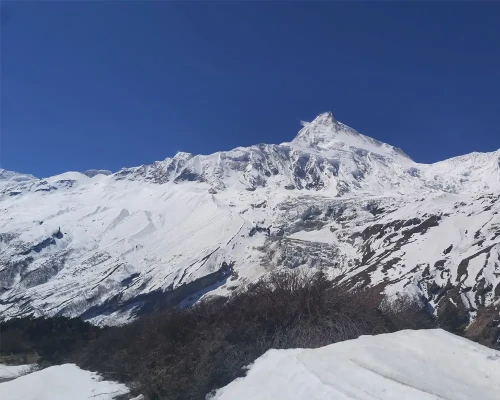
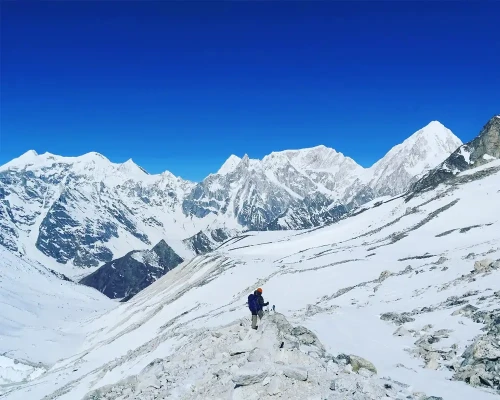
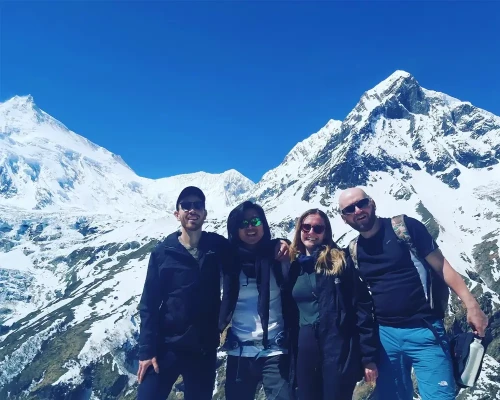
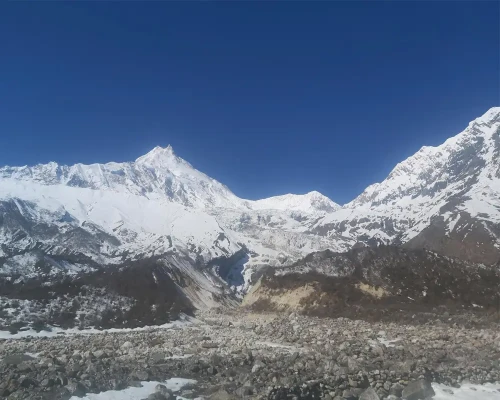
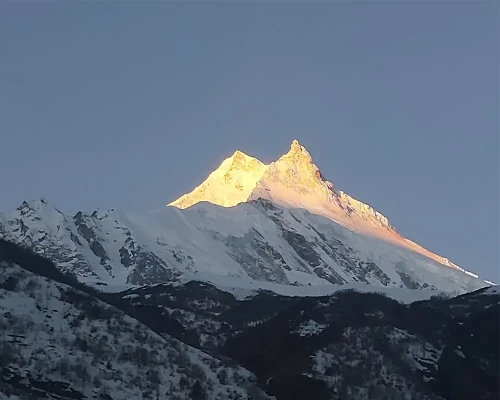
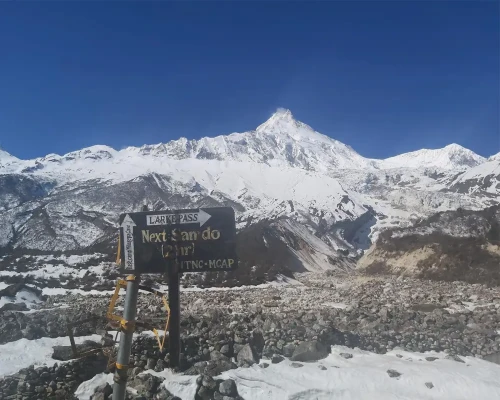

 based on 83 reviews
based on 83 reviews




